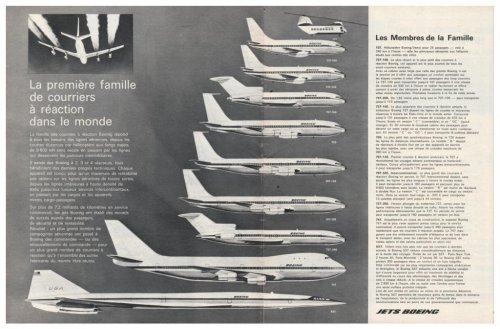- Joined
- 30 November 2007
- Messages
- 1,089
- Reaction score
- 429
Dear Boys and Girls, here is a striking Boeing Aircraft Company advertisement in French from the 15th November 1967 issue of Aviation Magazine International. It dates from the time of the formation of Airbus Industrie and it proclaims Boeing's ability to offer a full range and family of aircraft products.
It shows (to me) that Vickers/BAC, Sud Aviation, De Havilland/Hawker Siddeley, Convair & Fokker never really stood a chance. As it turns out, Lockheed & McDonnell-Douglas were unable to compete in the longer term. To me, it puts paid to bleating about Vickers VC-7s, Airco DH.121 Medway Tridents and VC10 conspiracy theories; shows the fallacy of tailoring a commercial airliner design to the requirements of a single customer and how the failure to offer/continue to develop a family of aircraft means loss of the customer base
Am I being controversial?
Terry (Caravellarella)
It shows (to me) that Vickers/BAC, Sud Aviation, De Havilland/Hawker Siddeley, Convair & Fokker never really stood a chance. As it turns out, Lockheed & McDonnell-Douglas were unable to compete in the longer term. To me, it puts paid to bleating about Vickers VC-7s, Airco DH.121 Medway Tridents and VC10 conspiracy theories; shows the fallacy of tailoring a commercial airliner design to the requirements of a single customer and how the failure to offer/continue to develop a family of aircraft means loss of the customer base
Am I being controversial?
Terry (Caravellarella)

